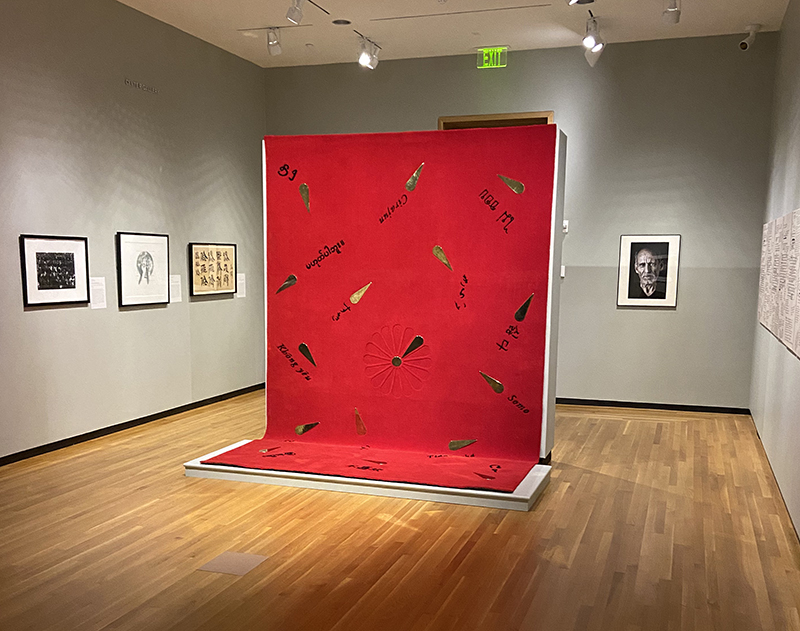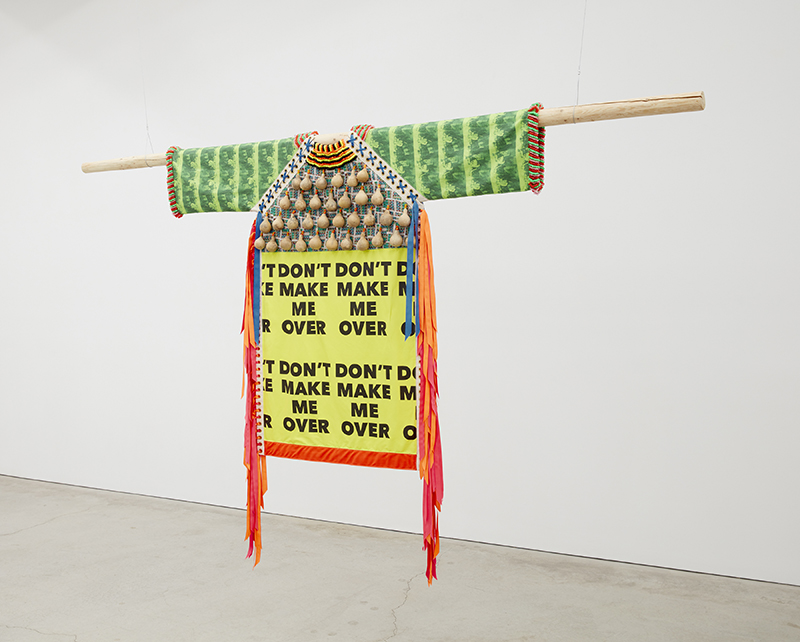Introducing “Turn of Phrase: Language and Translation in Global Contemporary Art”
By Bowdoin College Museum of Art
Installation view, Turn of Phrase: Language and Translation in Global Contemporary Art, featuringLoves Me, Loves Me Not, 1997, wool carpet and brass “petals” on jute backing, 144 x 96 in. (365.76 x 243.84 cm) by Yukinori Yanagi. Bowdoin College Museum of Art, Archival Collection of Marion Boulton Stroud and Acadia Summer Arts Program, Mt. Desert Island, Maine. Gift from the Marion Boulton “Kippy” Stroud Foundation. ©️ YANAGI STUDIO
In December, the Bowdoin College Museum of Art opened Turn of Phrase: Language and Translation in Global Contemporary Art, an exhibition examining the critical and creative functions of language in global contemporary art from the 1980s to the present. Featuring more than 20 works in a variety of media—including pieces by Marta María Pérez Bravo, Song Dong, Barbara Kruger, William Kentridge, Glenn Ligon, Shirin Neshat, Lorna Simpson, Wang Tiande, along with newly acquired works by Luis Camnitzer, Jeffrey Gibson, and Hung Liu—the exhibition provides vibrant examples of how the use of language is embedded in art, and how its presence affects and challenges the viewer’s encounter with a work. The exhibition is curated by Sabrina Lin, the Museum’s curatorial assistant and manager of student programs, and will be on view through June 4, 2023.
“For me, art and language have always operated in tandem as a mirror though which we see and situate ourselves in relation to the world,” said Lin. “This exhibition highlights the diverse ways artists use language to give voice to their work, from the experience of reading, viewing, and even activating the viewer’s body to explore complex issues of identity and belonging. While the exhibition highlights many prominent international artists, it also pushes back against the notion that ‘global contemporary art’ has a universal voice. By focusing on the important role of translation, which requires nuance and specificity, I consciously draw on the positionality of language to hopefully disrupt some of our inherent cultural biases and assumptions.”
Turn of Phrase draws on works in the Museum’s permanent collection, as well as new acquisitions that will be on view for the first time. Some works communicate their meaning(s) more directly, such as Jeffrey Gibson’s mixed media work The Anthropophagic Effect, Garment no. 3 (2019), which combines pop culture and political references with Indigenous craft techniques—including different textiles and beads—and their usage in storytelling. Barbara Kruger’s photolithograph and silkscreen work Untitled (We will no longer be seen and not heard) (1990) uses photographs of people in different gestural poses, with her characteristic blocks of letters and words such as “no,” “seen,” and “heard” screened onto the images.
The show also emphasizes language’s capacity for innovation, intervention, and disruption, both in terms of the viewer’s experience but also in some cases through a re-examination of the past. For example Liu’s piece, Western Pass (1990), depicts a heart wrenching scene of two prisoners on the verge of public execution, an ancient, Tang Dynasty poem written between them. Yet the figures come from a book exploring Chinese people and culture through Western eyes, casting both the imagery and the poem into a different light. Loves Me, Loves Me Not (1997), a monumental carpet by Yanagi Yukinori displays fifteen petals of the chrysanthemum flower, the Japanese imperial crest, each accompanied by a phrase written in languages that correspond to Japan’s former colonies. The work compels viewers to reckon with the past through the presence of multiple languages, further emphasizing the need to “surface” voices of historically marginalized individuals.
Likewise, Xu Bing’s Quotation from Chairman Mao (2001) plays with two stereotypes: perceptions of Chinese calligraphy and of the cultural omnipresence of quotes from Mao. The work challenges the viewer to decode what are actually English words written through stylized letters in the Roman alphabet. At the same time, the artist’s use of English makes the “calligraphy” inscrutable to any audience that does not read English. In a similar vein, Meleko Mokgosi’s Modern Art: The Root of African Savages (2013), is a six-panel work that uses museum wall labels as source materials: the artist deconstructs the power dynamics and cultural biases in these ostensibly “neutral” explanations offered to visitors, revealing the implicit biases in the cultural sector, despite its “global” ambitions.
 “Turn of Phrase is an insightful and creative exploration of the ways in which many of us take language and its uses for granted,” said Anne Collins Goodyear, co-director of the Bowdoin College Museum of Art. “The show also reveals something new about each work through the creative juxtapositions, demonstrating how important place can be in the presentation and experience of art.” Added Frank Goodyear, co-director of the Bowdoin College Museum of Art, “We are always so pleased and impressed by the work of our curatorial assistants, and Sabrina Lin’s work—culminating in this exhibition—is no exception. As a museum on a college campus, we think that providing opportunities for students and recent graduates to learn about museum work by doing museum work is essential, and the results always bring forward new insights and perspectives that benefit us as well as our audiences."
“Turn of Phrase is an insightful and creative exploration of the ways in which many of us take language and its uses for granted,” said Anne Collins Goodyear, co-director of the Bowdoin College Museum of Art. “The show also reveals something new about each work through the creative juxtapositions, demonstrating how important place can be in the presentation and experience of art.” Added Frank Goodyear, co-director of the Bowdoin College Museum of Art, “We are always so pleased and impressed by the work of our curatorial assistants, and Sabrina Lin’s work—culminating in this exhibition—is no exception. As a museum on a college campus, we think that providing opportunities for students and recent graduates to learn about museum work by doing museum work is essential, and the results always bring forward new insights and perspectives that benefit us as well as our audiences."
On Thursday, January 26 at 4:30 p.m., Lin will provide a public tour of the exhibition, which will be followed by a reception in the Museum’s glass entrance pavilion. We look forward to sharing this exhibition,other exciting offerings at the BCMA in the new year.
Sabrina Lin
Curatorial Assistant and Manager of Student Programs
Illustration: The Anthropophagic Effect, Garment no.3, 2019. Mixed media with cotton, brass grommets, nylon thread, artificial sinew, dried pear gourds, glass and plastic beads, nylon ribbon on canvas, by Jeffrey Gibson. Bowdoin College Museum of Art, Museum Purchase, Lloyd O. and Marjorie Strong Coulter Fund. © Jeffrey Gibson